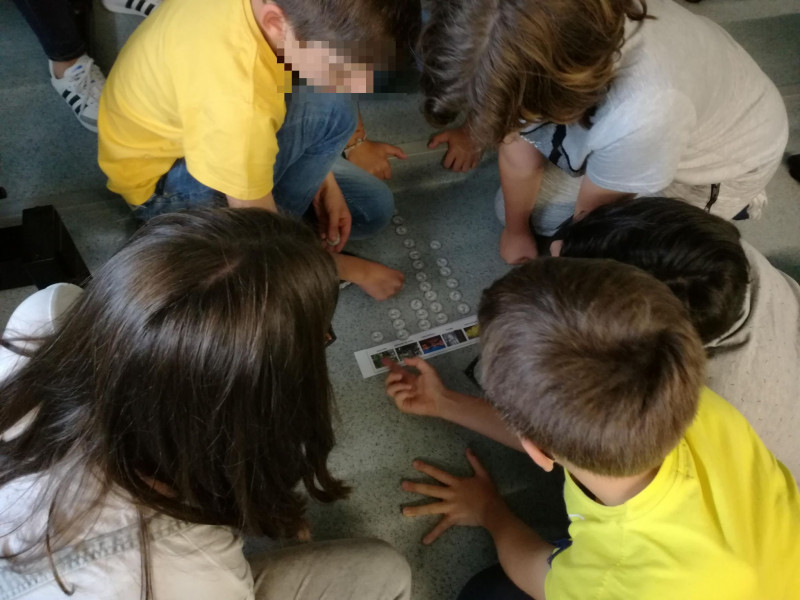How to contribute to a social just world? The experience in Portugal
3. Children take action
3.1. Inequalities in trade (Age range: 7+)
In small groups, children discuss how they would divide 30 coins between those involved in the banana trade process: farmer, plantation owner, transporter, factory and supermarket.
The activity can be implemented in the ISOTIS platform and complemented by using physical coins and paper cards (each card representing one of those involved in the trade process).
At the end, in whole group, children are confronted with the real values:
- Supermarket: 13 coins
- Factory: 7 coins
- Transporter: 5 coins
- Plantation: 3 coins
- Farmer: 2 coins
A discussion can be held about the fairness of the distribution and possible solutions to mitigate inequalities.
children between 7 and 10 years old
Children between 7 and 10 years old were involved in the VLE activity, dividing 30 coins between those involved in the process of trade as they thought it would be fair. After all children completed the activity, the researchers presented a Power-Point with a summary of children’s responses on the distribution and reasons for that distribution and the actual distribution of money.

When confronted with the real values on a chart, children immediately showed outrage and expressed their surprise. One child exclaimed “What?! How unfair!”. When asked to comment the results, children argued that the supermarket had less work when compared with others, although it received the most (“it’s unfair because the supermarket does almost anything and receives so much” and “the supermarket just has to make calculations and receives almost everything”). On the other hand, children highlighted the farmer’s hard work (“the farmer has to work day and night and walk in the rain and the supermarket does not”). One of the children voiced “I want everyone to receive the same amount because everybody works”. When asked by the teacher about why this happens, a child referred “because the supermarket wants to have a lot of money and because of that keeps all the money to itself”.
Then, children were invited to think about solutions ("what can we do?"). Although one child immediately expressed “nothing”, other children were full of ideas. On one hand, children highlighted how transparency in the amounts received by each part could help us as consumers (“we can go to the supermarket and ask how much each one receives”). On the other hand, children proposed advocating for farmers’ rights in different ways (“we can go with the farmer to the supermarket and ask more money for him”, “we can give food to the farmer”, “we can help the farmer plant things”, “we can do a manifestation”). One child also proposed to “call the police and complain”. Another referred “I know who can help us” and mentioned “Marcelo Rebelo de Sousa”, the Portuguese president, but was unsure about what he could specifically do. The teacher suggested that maybe some legislation could be designed and implemented to regulate the percentage that farmers should receive and protect them. Another child proposed that planters spoke with each other and stopped selling until a just price was proposed to them. The teacher advance with the ideas of buying directly to farmers or in little grocery stores, markets, and fairs. Finally, Fairtrade was also mentioned as an alternative to diminishing the inequalities in trade.
CHILDREN BETWEEN 10 AND 12 YEARS OLD

Older students (12 to 15 years old) implemented this activity with their younger peers (10 to 12 years old). Contrarily to younger students, they were asked to guess how the distribution would be. Some interesting discussions and reflections arose. Regarding the income of the farmer, some children claimed “the farmer is going to receive less”, “the farmer is more explored, so he receives less”, “the farmer [receives less] because his profession isn’t as valued and is done in a poor country”, others stated “I think the farmer receives more”, “I think that the farmer should receive more”, and “he isn’t paid as he should be”. Moreover, they also considered factors as the number of persons employed and additional costs (e.g., “the supermarket has more employees”, “the transporter spends money on gas”, and “the factory should receive more, because lots of persons work there and they need to pay for the machines’ maintenance”.
When faced with the real values, in the whole group discussion, students’ thoughts regarding the farmer’s payment were: “it’s unfair”, “the farmer should receive way more”, “the farmer does most of the work, he plants” and “the farmer doesn’t surprise me, it is not a job that is highly recognized, valued”. Concerning the supermarket, students referred that “the supermarket only sells”, “as it is the supermarket that sells the products, it receives more” and “all the money goes to the boss”. When considering the amount that went to the factory, they reinforced “I was surprised with the factory, they have lots of persons there working” and “the factory should earn a bit more, they have expenses with the equipment”. Also, one student expressed “the transporter should earn more, he does big distances sometimes”.
Links with the curriculum:
- Mathematics: awareness of numbers and division;
- Citizenship education: interculturality, human rights and social justice.